fuel BUICK PARK AVENUE 1998 Owners Manual
[x] Cancel search | Manufacturer: BUICK, Model Year: 1998, Model line: PARK AVENUE, Model: BUICK PARK AVENUE 1998Pages: 426, PDF Size: 23.59 MB
Page 11 of 426
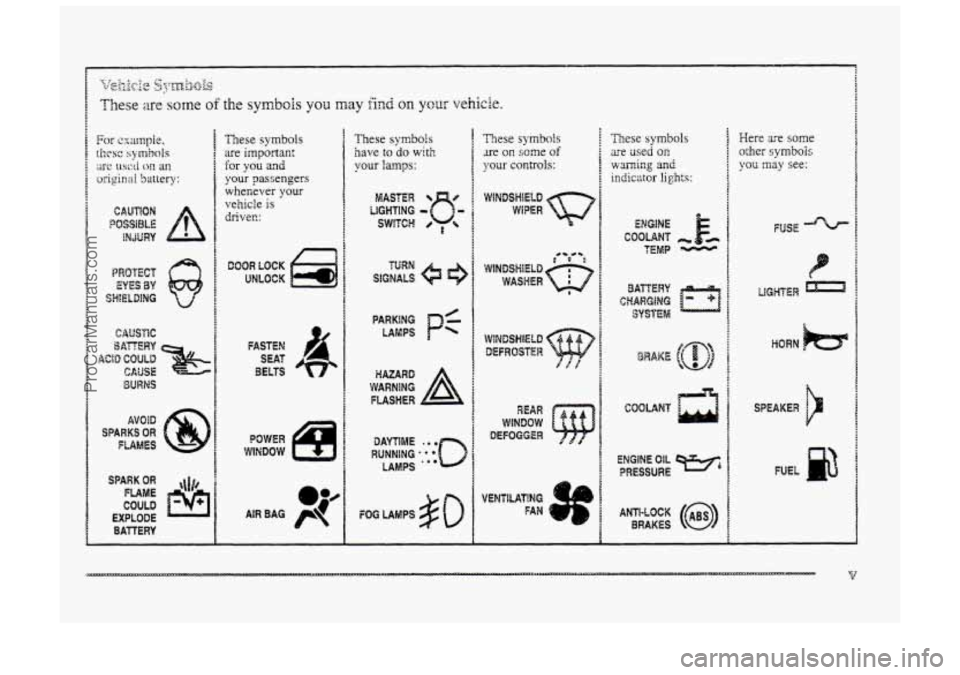
CAUSPlC
BURNS
SPARK OR ql!,
COULD
FUME
EXPLODE
BATTERY
I F
1 :
f
I
1
These symbols
are important
for you and
your passengers whenever your
vehicle
is
driver.:
DOOR LOCK
UNLOCK
POWER
WINDOW
These symbols
have to do with
your lamps:
I. These symbols i These symbols
are on some of ' are used OR
your controls: wming and
[ indicator lights: i
WEWTkATIMG
FAN
BRAKE
ANTI-LOCK (e)
BRAKES
Here xe some
other symbols
you may see:
SPEAKER
FUEL
ProCarManuals.com
Page 84 of 426
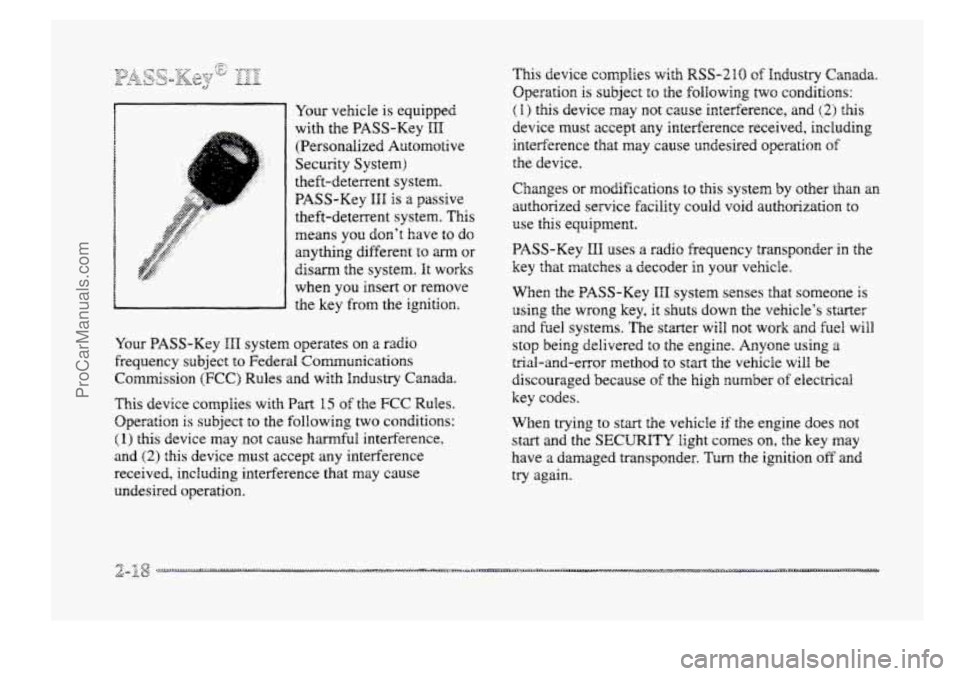
Your vehicle is equipped
with the PASS-Key
III
(Persondized Automotive
Security System)
theft-deterrent system.
PASS-Key
HHI is a passive
theft-deterrent system.
This
means you don’t have to do
anything different to arm or
disarm the system. It works
when YOU insert or remove
the key
from the ignition.
Your PASS-Key
III system operates on a radio
frequency
subject to Federal Communications
Commission
(FCC) Rules and with Industry Canada.
This device complies
with Part 15 of the FCC Rules.
Operation
is subject to the following two conditions:
(I) this device may not cause harmful interference,
and
(2) this device must accept any interference
received, including interference that may cause
undesired operation.
This device complies with RSS-210 of Industry Canada.
Operation
is subject to the following two conditions:
(I) this device may not cause interference, and (2) this
device must accept any interference received, including
interference that may cause undesired operation
of
the device.
Changes
or modifications to this system by other than an
authorized service facility could void authorization to
use this equipment.
PASS-Key
HI1 uses a radio frequency transponder in the
key that matches a decoder in your vehicle.
When the PASS-Key
III system senses that someone is
using the wrong key, it shuts
down the vehicle’s starter
and fuel systems.
The starter will not work and he8 will
stop being delivered to the engine. Anyone using a
trial-and-error method to start the vehicle will be
discouraged because
of the high number of electrical
key codes.
When trying
to start the vehicle if the engine does not
start and the SECURITY light comes on, the key may
have
a damaged transponder. Turn the ignition off and
try again.
ProCarManuals.com
Page 89 of 426
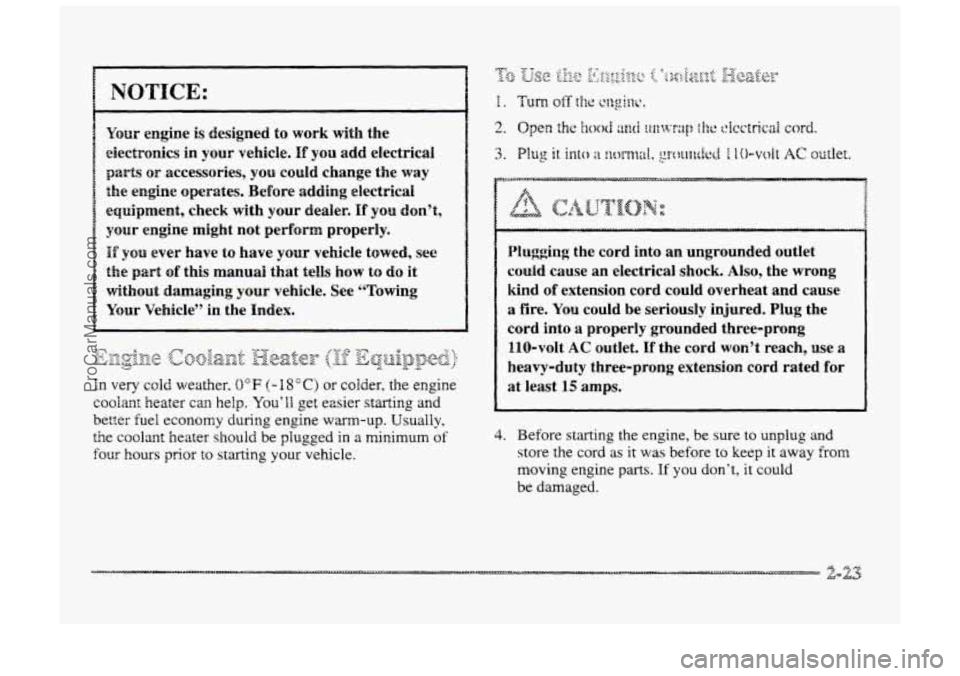
NOTICE:
Your engine is designed to work with the
electronics
in your vehicle. If you add electrical
parts OF accessories, you could change the way
the engine operates. Before adding electrical
equipment, check with your dealer.
If you don’t,
your engine might not perform properly.
If yon ever have to have your vehicle towed, see
the past of this manual that tells how to do it
without damaging your vehicle. See “Towing
Your Vehicle” in the Index.
In very cold weather, 0 OF (- I 8 O C) or colder, the engine
coolant
heater can he8p. You’ll get easier starting and
better fuel economy during engine wm-up. Usually,
the coolant heater should be plugged in a minimum of
four hours prior to starting your vehicle.
I_ -I
cigUTE[y%q @ -. .. b.8
Plugging t.he cord into an ungrounded outlet
could cause an electrical shock. Also, the wrong
kind of extension cord could overheat and cause
a fire. You could be seriously injured. Plug the
cord into
a properly grounded three-prong
110-volt
AC outlet. If the cord won’t reach, use a
heavy-duty three-prong extension cord rated for
at least
15 amps.
4. Before starting the engine, be sure to unplug and
store the cord as it was before to keep it away from
moving engine parts. If you don’t, it could
be damaged.
ProCarManuals.com
Page 92 of 426
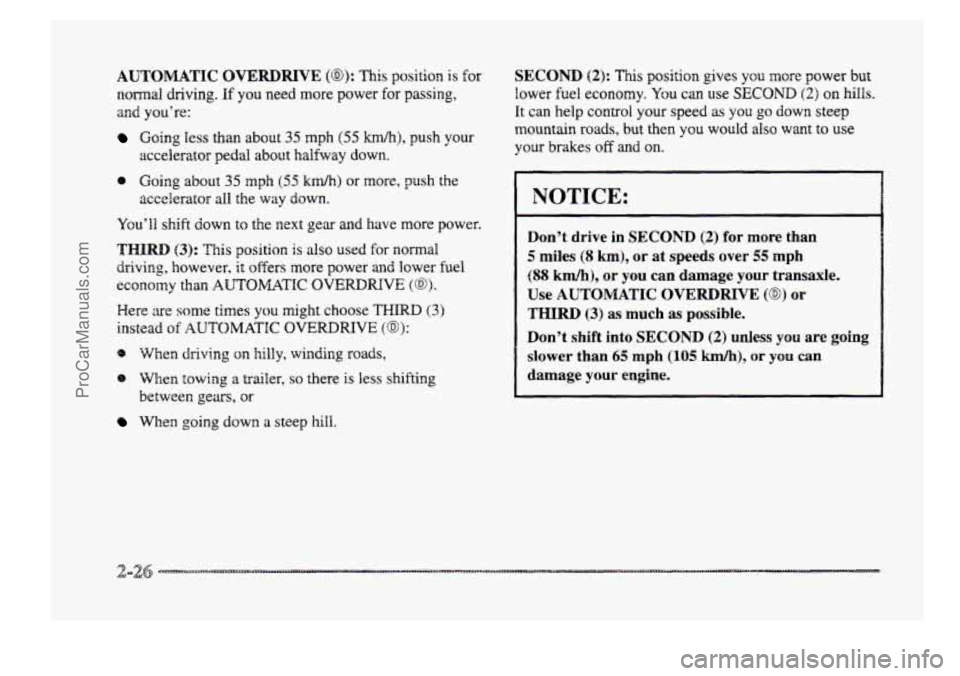
AUTOMATIC OVERDRIVE (@):This positionis for
normal driving. Pf you need more power for passing,
and you’re:
Going less than about 35 mph (55 kmh), push your
accelerator pedal about halfway down.
e Going about 35 mph (55 kmh) or more, push the
accelerator
all the way down.
You’U shift down to the next gear and have more power.
THIRD (3): This position is also used for normal
driving, however, it offers more power and Bower fuel
economy than AUTOMATIC OVERDRIVE (0).
Here are some times you might choose THIRD (3)
instead of AUTOMATIC OVERDRIVE (a):
Qb When towing a trailer, so there is less shifting
between gears,
or
SECQND (2): This position gives you nore power but
lower fuel economy. YQU can use SECOND (2) on hills.
It can help control your speed as you go down steep
mountain roads, but
then you would also want to use
your
brakes off and on.
NOTICE:
Don’t drive in SECOND (2) for more than
5 miles (8 km), or at speeds over 55 mph
(88 km/h), or you can damage your transaxle.
Use AUTOMATIC OVERDRIVE (0) or
THIRD (3) as much as possible.
Don’t shift into SECOND
(2) unless you are going
slower than
65 mph (105 km/h), or you can
damage your engine.
When going down a steep hill.
ProCarManuals.com
Page 93 of 426
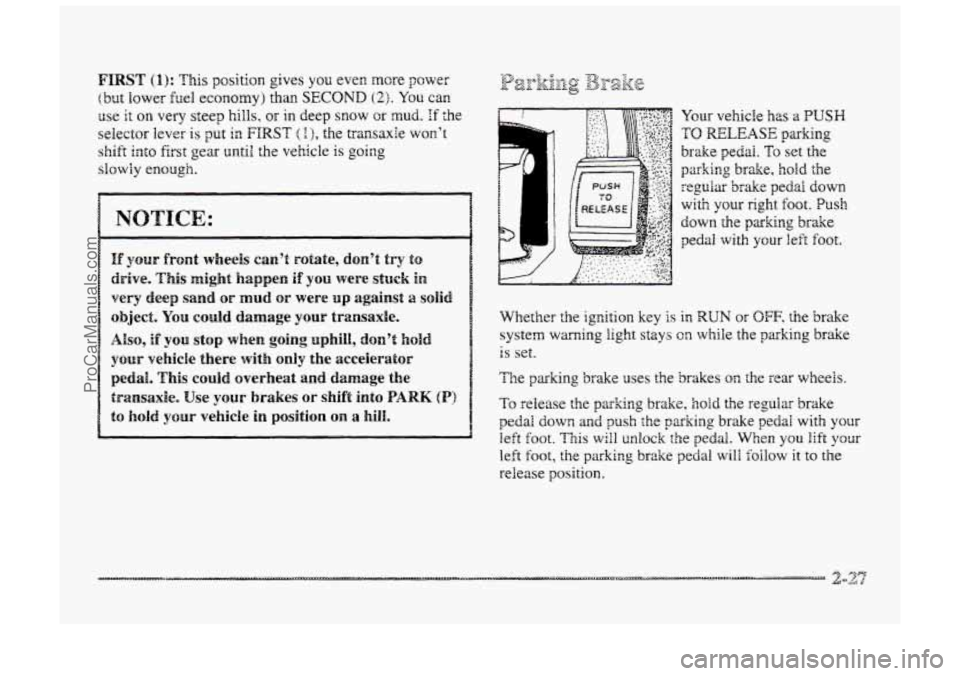
FIRST (I): This position gives you even more power
(but lower fuel economy) than SECOND (2). You can
use it on very steep hills, or in deep snow or mud. If the
selector lever is put in FIRST ( I >, the transaxle won’t
shift into first gear until the vehicle is going
slowHy enough.
If your hplrt wheels can’t rotate, don’t try to
drive. This might happen if YOU were stuck in
very deep sand OF mud or were up against a solid
object. You could damage your transaxle.
Also, if you stop when going uphill, don’t hold
your vehicIe there with only the accelerator
pedal. This could overheat and damage the
transaxle. Use ysur brakes or shift into BARK (P)
Your vehicle has a PUSH
TO RELEASE parking
brake pedai. To set the
parking brake, hold the
regular brake pedal down
with your right foot. Push
down the papking brake
pedal with your left foot.
~~ ~~
Whether the ignition key is in RUN or OFF. the brake
system
wming light stays on while the parking brake
1s set.
The parhng brake uses the brakes the rear wheels.
To release the parking brake, hoki the regular brake
pedal down and push the parking brake pedal with your
left foot. This will unlock the pedal. When you lift your
left foot, the parking brzke pedal will foilow it to the
release position.
ProCarManuals.com
Page 146 of 426
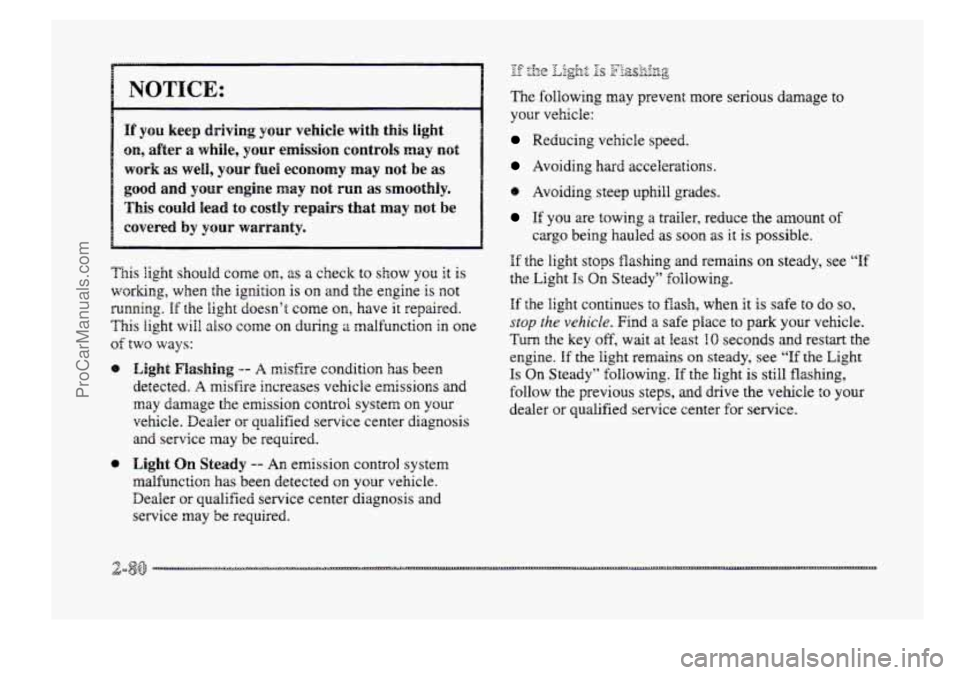
NOTICE:
If you keep driving your vehicle with this light
on, after a whiie, your emission controls rnay not
work as well, your fuel economy may not be as
good and your engine may not PUR as smoothly.
This could lead to costly repairs that may not be
covered by pur warranty.
This jight should corne on, as a check to show YOU it is
working, when the ignition is
on and the engine is not
running. If the light doesn’t come on, have it repaired.
This light will also come QII during ;I malfunction in one
of ~WO ways:
8 Light Flashing -- A misfire condition has been
detected.
A misfire increases vehicle emissions and
may damage the emission controi system on your
vehicle. Dealer or qualified service center diagnosis
and service rnay be required.
@ Eight On Steady -- An emission control system
malfunction
has been detected on your vehicle.
Dealer
or qualified service center diagnosis and
service
may be required.
-.- 8:. f. ,fie ~ 2s F‘fp&-!&g --
The following may prevent more serious damage to
your vehicle:
Reducing vehicle speed.
Avoiding hard accelerations.
e Avoiding steep uphill grades.
If YOU are towing a trailer, reduce the amount of
cargo being hauled as soon as it is possible.
If the light stops flashing and remains on steady, see “If
the Light Is On Steady” following.
Sf the light continues to flash, when it is safe to do so,
stop the vehicle. Find a safe place to park your vehicle.
Turn the key off, wait at least IO seconds and restart the
engine.
If the light remains on steady, see “If the Light
Is On Steady” following. If the light is still flashing,
follow the previous steps,
and drive the vehcle to your
dealer or qualified service center €or service.
ProCarManuals.com
Page 147 of 426
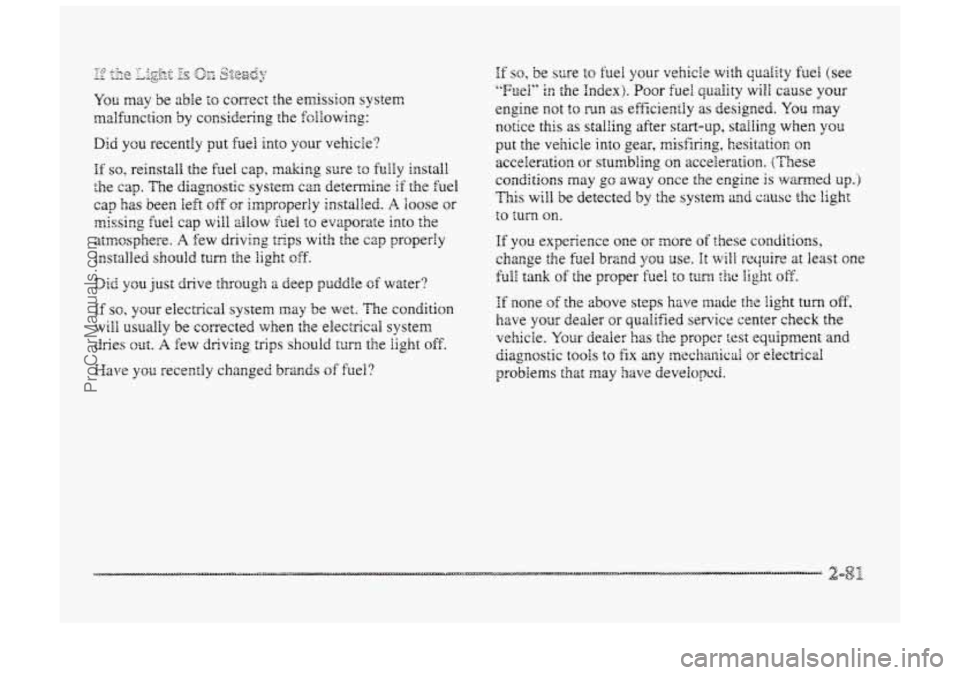
If so, your electrical system may be wet. The condition
will usually be cgrrected when the electrical system
dries out. A few driving trips should turn the light off.
Maw
you recently changed brands of fuel?
If so, be sure to he1 your vehicie with quality fuel (see
"Fuel" in the Index). Poor fuel quality will cause your
engine not to FJ~ as efficiently as designed. YQU may
notice this as stalling after start-up, stalling when you
pent the vehicle into gear, misfiring, hesitation on
acceleration or stumbling on acceleration. (These
conditions may
go away once the engine is warned up. j
This will be detected by the system and cause the light
to turn OR.
If you experience one or more of these conditions,
chmge the fuel
brand you use. It will n-ecpire at least one
full tank of the proper fuel to tuna the light off.
If none of the above steps hove lrirade the light turn off,
have your dealer or qualified service center check the
vehicle. Your dealer has the proper test equipment and
diagnostic tools to fix any nnechanicai or electnictrl
problems that
may have developed.
ProCarManuals.com
Page 149 of 426

'
SERVICE
VEHICLE
non-emission related
vehicle
problems.
SOON
These problems may not be obvious and may affect
vehicle performance or durability. Consult a qualified
dealership for necessary repairs to maintain top vehicle
performance. The
light will come QIP briefly when your
ignition is turned on to S~OW that it is workmg properly.
1 UNLEADED FUEL ONLY I
ProCarManuals.com
Page 153 of 426
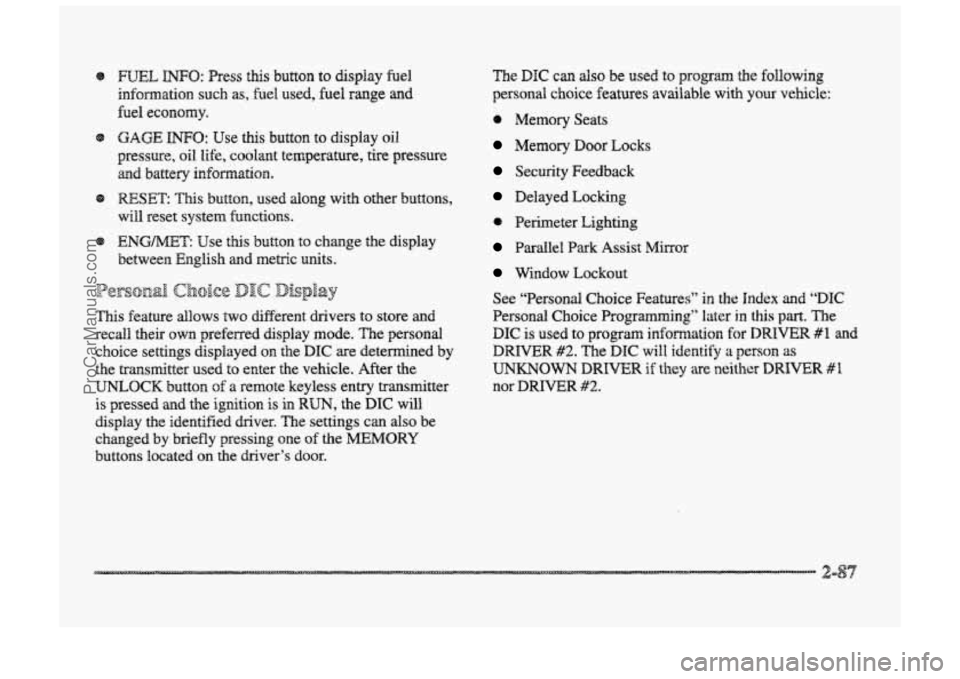
e mL INFO: Press this button to display fuel
infomation such
as, fuel used, fuel range and
fuel economy.
Q GAGE INFO: Use this button to display oil
pressure,
oil Me, coolant temperature, tire pressure
and battery infomation.
RESET: ”his button, used dong with other buttons,
will reset system functions.
@ ENGNET: Use this button to change the display
between English and metric
units.
p@r@-jn& Choice gJ1c DispEay
This feature allows two different drivers to store and
recall their
QWP~ preferred display mode. The personal
choice settings displayed
on the DIC are determined by
the transmitter used
t~ enter the vehicle. After the
UNLOCK button of a remote keyless entry transmitter
is pressed
and the ignition is in RUN, the DIC will
display
the identified driver. The settings can also be
changed
by briefly pressing one of the MEMORY
buttons located on the driver’s door.
The DIC can also be used to program the following
personal
choice features available with your vehicle:
e Memory Seats
Memory Door Locks
Security Feedback
Delayed Locking
e Perimeter Lighting
Parallel Park Assist Mirror
Window Lockout
See “Personal Choice Features”
in the Index and “DIC
Personal Choice Progran~ning’~ later in this part. The
DIC is used to program infomation €or DWIVEiR #1 and
DRIVER #2. The DIC will identify a person as
UNKNOWN DRIVER if they are neither DRIVER #I
nor DRIVER #2.
ProCarManuals.com
Page 154 of 426
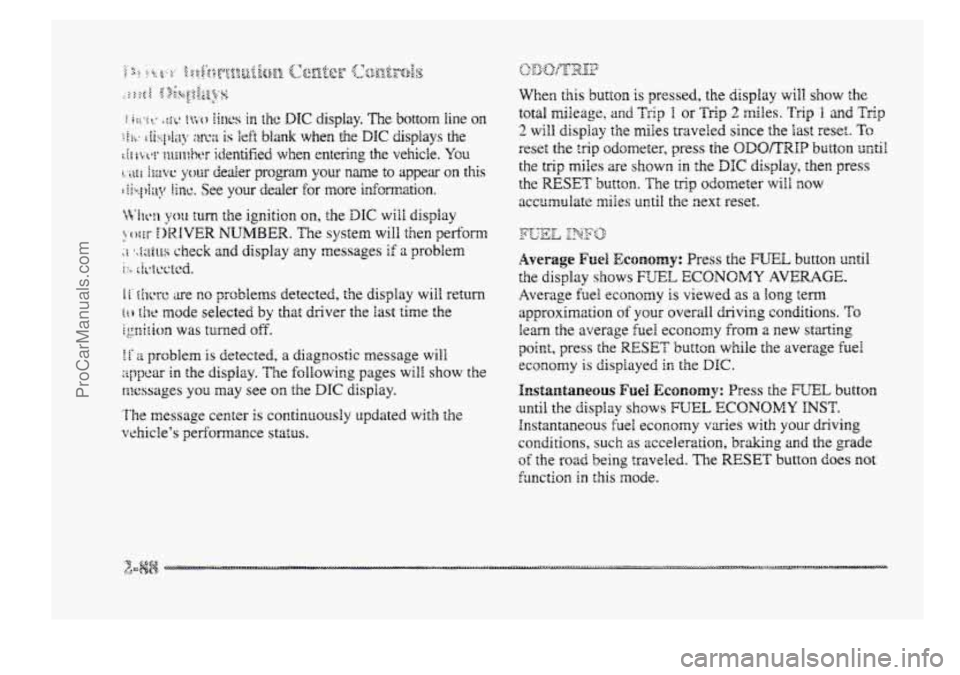
it ~hcre are no problems detected, the display will return
[ti he mode selected by that driver the last time the
ignition was turned off.
1 f 2 problem is detected, a diagnostic message will
appear in the display. The following pages will show the
messages you may see on the DIC display.
The message center is continuously updated with the
vehicle's performance status.
When this button is pressed, the display will show the
total mileage, an;d Trip T or Trig 2 miles. Trip I and Trip
2 will display the miles traveled since the last reset. To
reset the trig odometer, press the ODOKMP button until
the trig miles are shown in the DIC display, then press
the RESET button. The trip odometer will f~ow
accumulate miles until the next reset.
Average Fue% ECCD~Q~Y: Press the WEE button mtil
the display shows FUEL ECONOMY AVERAGE.
Average fuel economy is viewed as a long term
approximation of your overall driving conditions. To
learn the average fuel econcrny from a new starting
point, press the RESET button while the average fuel
economy is displayed in the D6C.
F~S~UI&~IEQUS Fuel ECQKIOH~~: Press the FUEL button
until the display shows FUEL ECONOMY INST.
Instantaneous fuel economy varies with your driving
conditions, such as acceleration,
braking and the grade
of the road being traveled. The RESET button does not
hnction
in this mode.
ProCarManuals.com